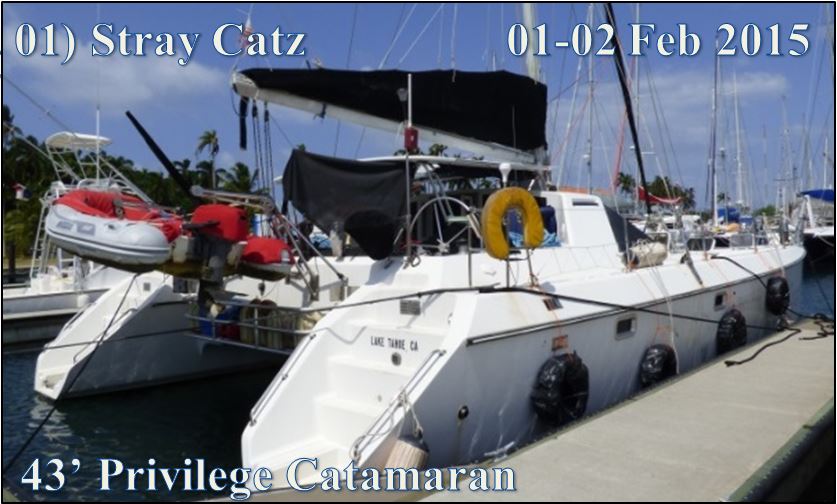Yacht transit #01 Stray Catz
Our transit through the Panama Canal on Stray Catz
01-02 February 2015 – 43′ Privilege Catamaran
US Brian & Anna Byrd, son Kylan, Panamanian friend Maribel, French cruisers Arnaud & Vincent
Advisors: Omar & Francisco
From the Stray Catz blog:
“We rafted up to another boat from the USA as we entered the locks. The up locks are much more challenging than the down lock, but the line handlers on Stray Catz (all volunteers) did an excellent job. The line handlers on the other boat two of which were professionals didn’t do as well. At one point the lines got loose and that meant Stray Catz was heading toward the big ugly concrete wall. They got the line under control and all was well, but lets just say there was some yelling on their boat and some scrambling with fenders on ours.”
“Our volunteer line handlers, Kylan, Russel, Dianne, Arnold and Vincent were fantastic. Thanks to all of them for keeping Stray Catz scratch and dent free. All did a wonderful job and were great company.”
Day One : Gatun Locks
We joined Stray Catz in Shelter Bay Marina at 13:00 as instructed, where everyone was supposed to be ready but the teenage son Kylan was still on the internet, and the French guys were late.
Brian, Anna and Kylan live on board the catamaran, and Maribel is their Panamanian friend along for the ride. Brian bought Stray Catz in the US over a year ago and they had gradually made their way to Panama, planning to go into the Pacific, however Kylan wants to check out colleges so they are now going to base themselves in Mexico for a while.
The two French guys are about to take their own boat through the Canal so they were very keen to do it on someone else’s boat first. This is very common in the marina it seems, so we were happy that we didn’t lose our spot on the trip.
We had a good size double cabin that Kylan was kicked out of. It was obvious that the boat is a catamaran with stuff balanced in all sorts of places. Anna kept talking about her kitchen, and Brian isn’t particularly nautical, but they have been on the boat for more than a year. The three of them get seasick so they mentioned wanting to get someone to help them get across the Pacific, mostly to be able to go down below and cook when it was rough! Don’t think either of us would be interested in taking a catamaran across an ocean.
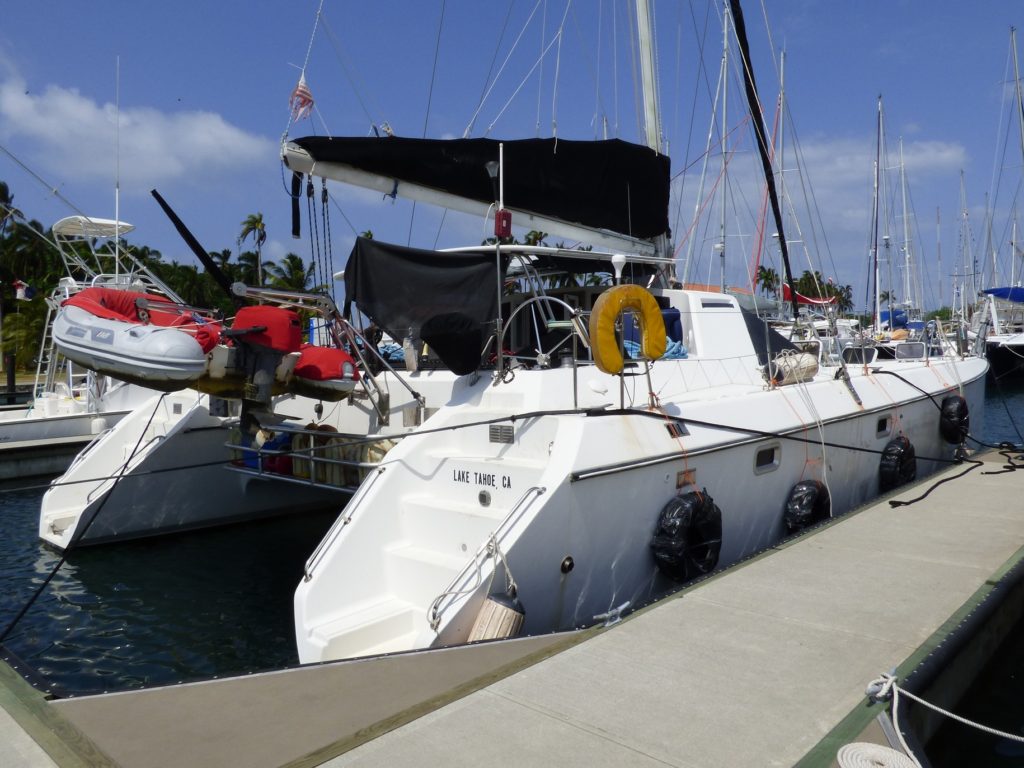
Stray Catz at Shelter Bay Marina
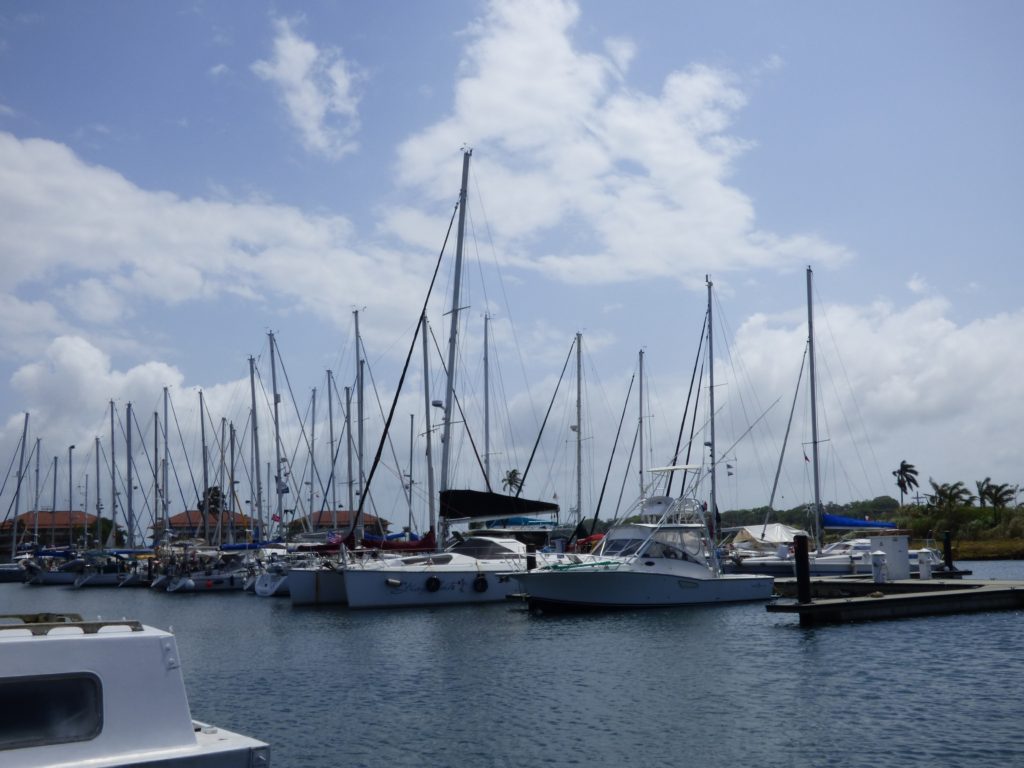
Shelter Bay Marina
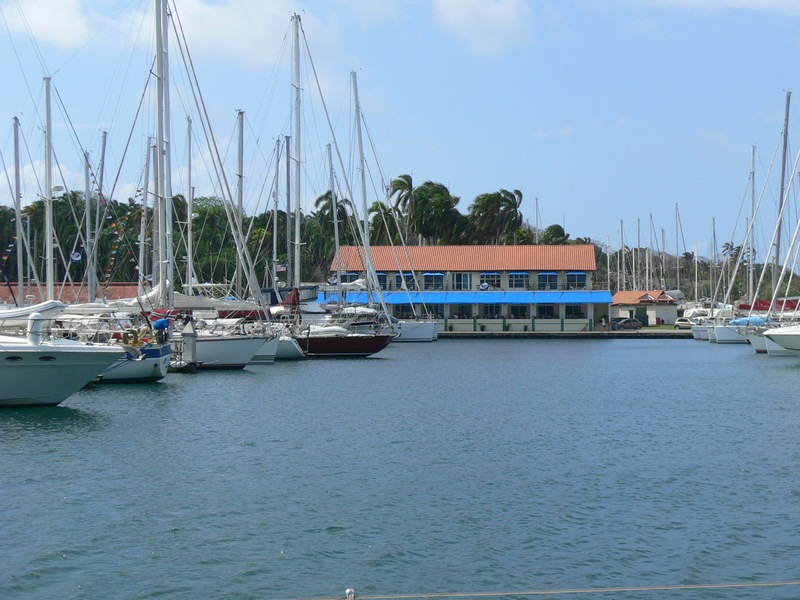
Shelter Bay Marina Hotel and Restaurant
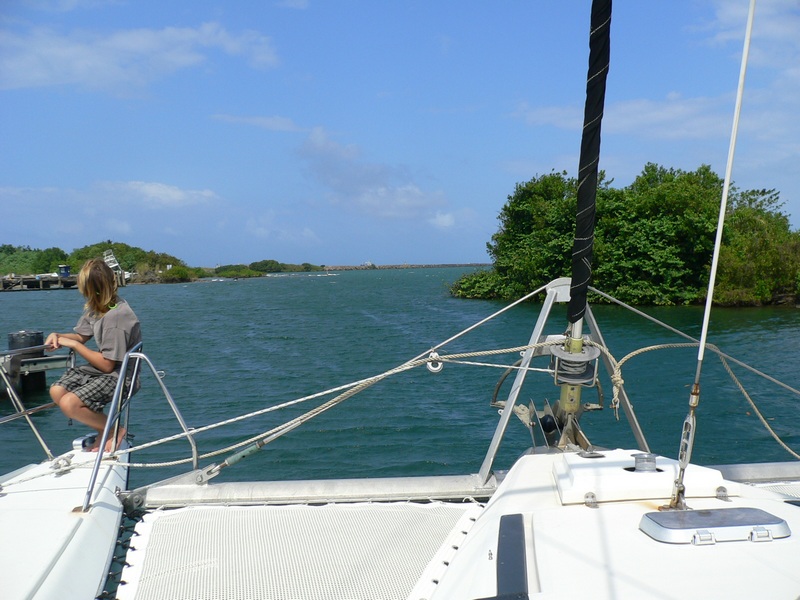
Heading out of the narrow entrance of Shelter Bay Marina
It was about 14:05 when we cast off and headed out of Shelter Bay Marina to make the 40-minute transit across to the Flats. The Advisor was supposed to appear at 16:00 but we soon heard that it would be 18:30. Lots of chat about what the Advisor had already told them, and what the other cruisers were saying about the trip. Plenty of rumours and scare-mongering about what can go wrong, and Brian admitted that he was scared and nervous, which the delay wouldn’t have helped. He is a recently retired Air Traffic Controller so we figured that stress was not going to be an issue.
Eight boats from the World ARC rally were to join us in the locks, so they gradually appeared all around us at the anchorage. We were told that we would be nested with one other yacht to go through Gatun Locks, so we got the lines ready for rafting up.
The agent provided car tyres wrapped in plastic to use as fenders, and four long blue polyprop mooring lines. Panamanian ropework had the mooring line eyes tied in a bowline with the tail ty-rapped and the ends wrapped in insulation tape.
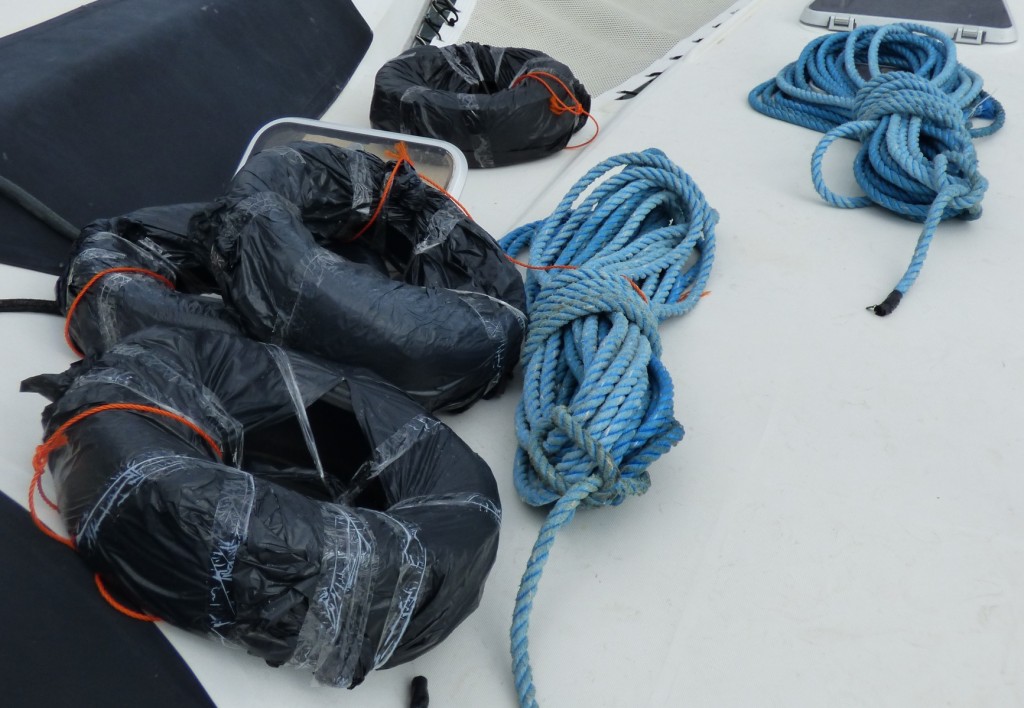
Standard transit fenders and ropes
The boat carrying the Advisor eventually arrived around 19:10 but it took some time before Omar would jump across. He kept shouting for a gate to be opened but there wasn’t one, so eventually he just jumped over the railing. It was good to see that the boat driver was very careful not to make contact with the yacht at all.
Omar soon explained some of how the lockage was going to work:
- We would motor over to the locks when they were ready, and raft up or nest with the other yacht just before moving into the lock.
- When nesting yachts the Advisor on the longest yacht is generally in charge, unless another yacht is more powerful
- There must be four linehandlers. In our case, two to handle the lines and two people armed with fenders
- Linehandlers should wear lifejackets in the locks, although the Advisor mentioned that if you fell in you would die anyway!
- Solar panels should be protected from the monkey’s fist on the heaving lines. We used some seat cushions
- When attaching the heaving line to the mooring rope the knot (usually a clove-hitch) should be off-centre so it doesn’t jam on the bollard
Around 20:00 we heard that the locking would not happen until 21:50, but we would be the last of the day so there was no time pressure to get through. We figured with nine private yachts it was going to take a while.
Anna brought out some chili and rice for dinner to keep us all going. Another of the horror stories is about the Advisors being fussy about food, and if they don’t like what you provide they order a meal that costs several hundred dollars to be delivered by fast ferry. Our guy seemed easily pleased at least.
Because we had extra crew, Russell and I were not nominated as linehandlers, but we helped out where we could, mostly with ensuring the mooring lines would run free. It was surprisingly quick to get the four rafts sorted out and moving into the canal.
The monkey’s fist was thrown from a great height, and one did indeed hit the solar panel, or fortunately the cushion we had tied over it. The guys on shore walked along the lock holding the heaving lines, and when we were in position they pulled the heavier mooring lines across.

Raft of yachts approaching Gatun Lock
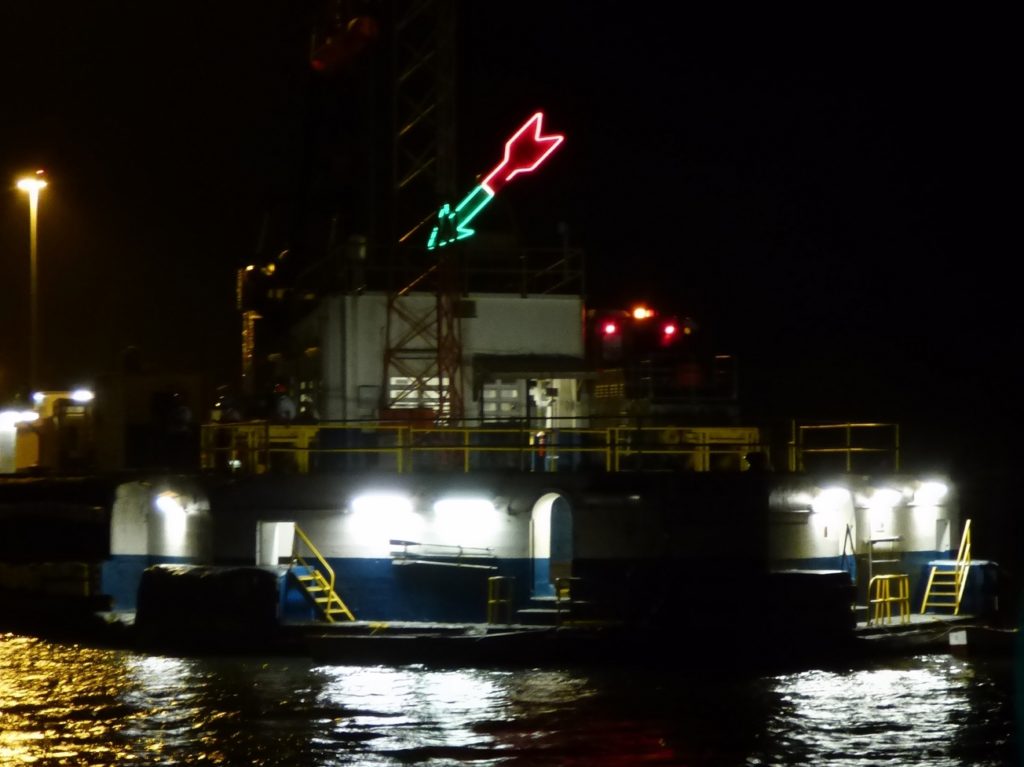
The arrows indicating when and where the ships are to enter
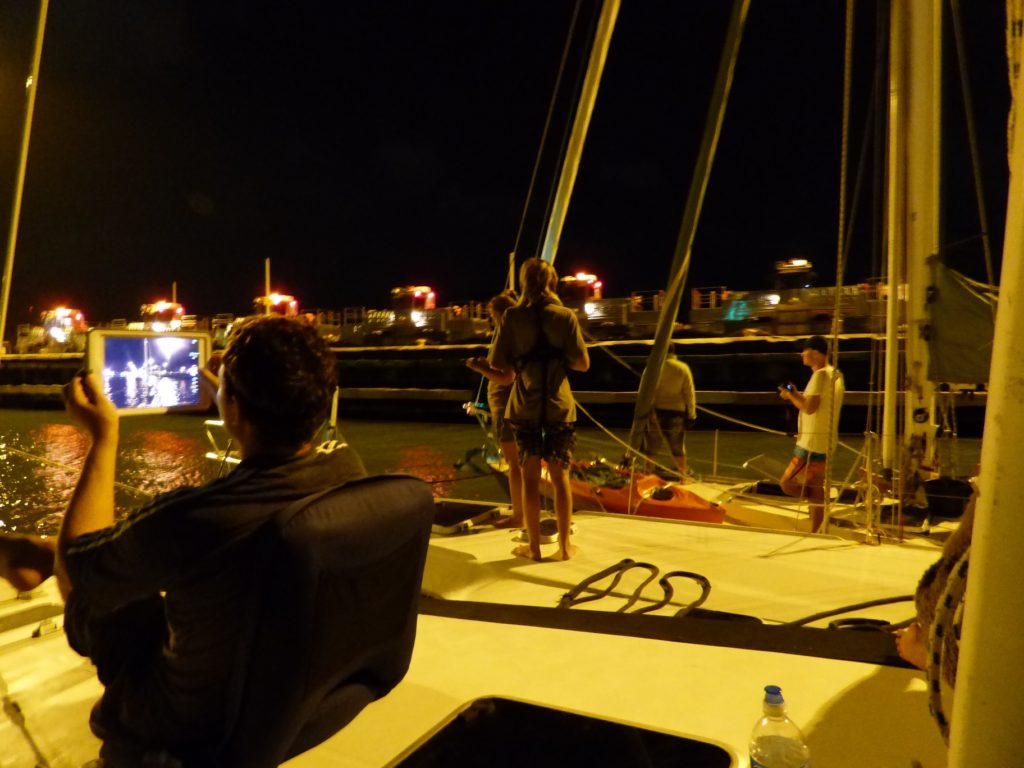
Moving into the chamber with a yacht tied alongside
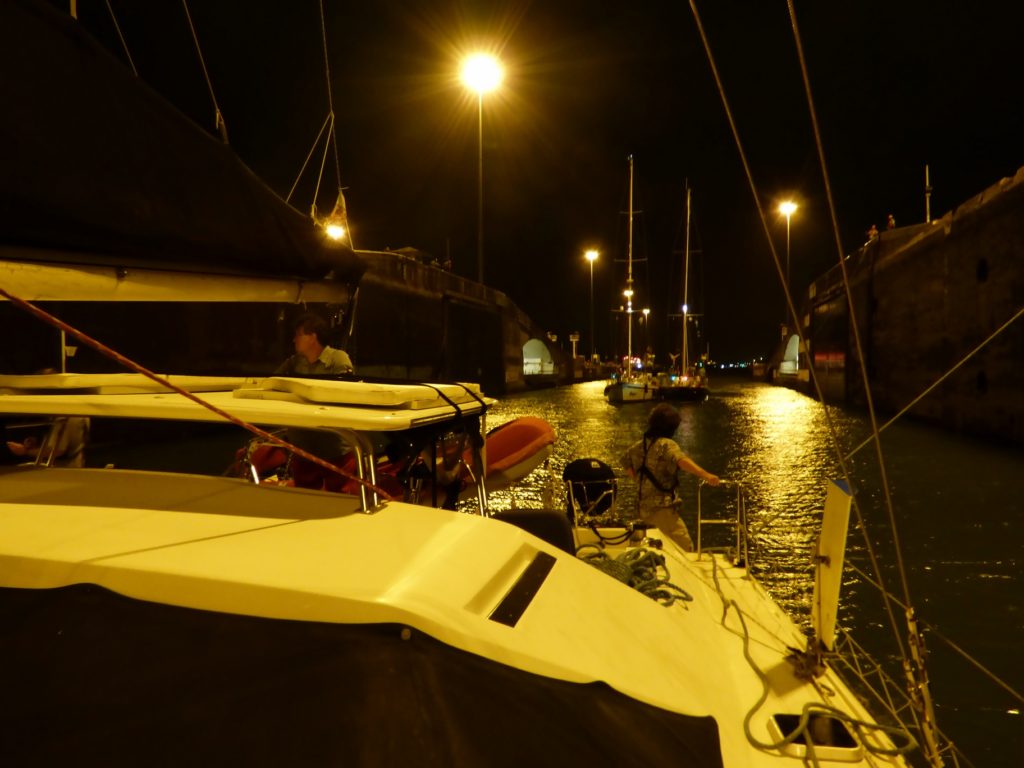
In the chamber
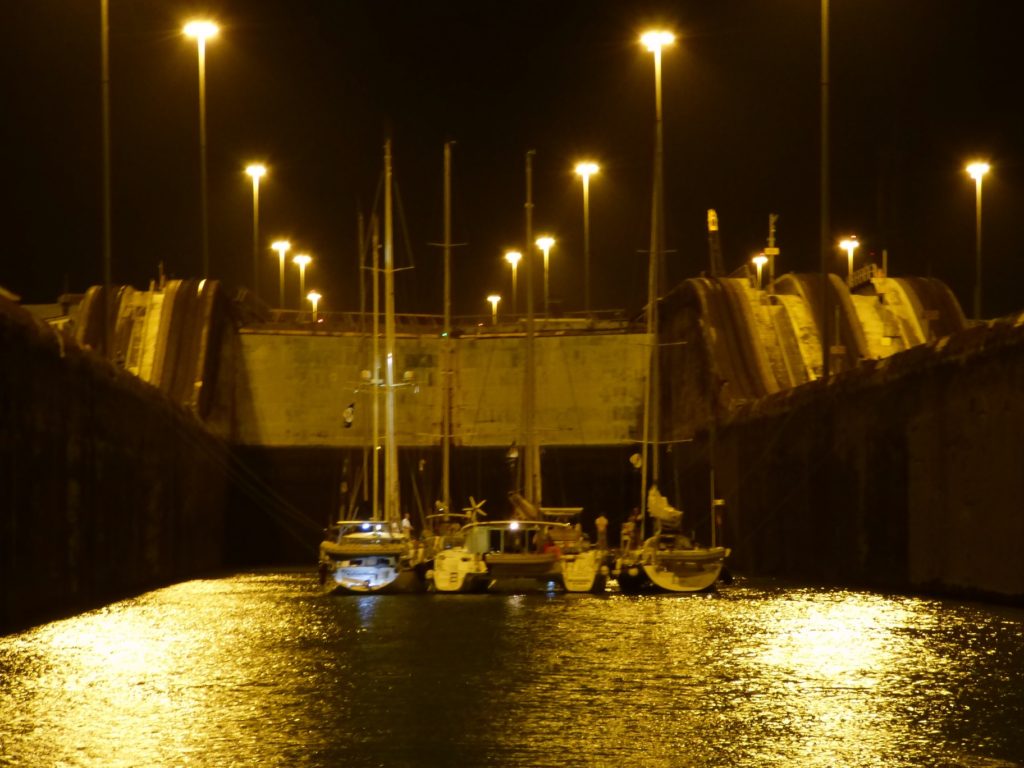
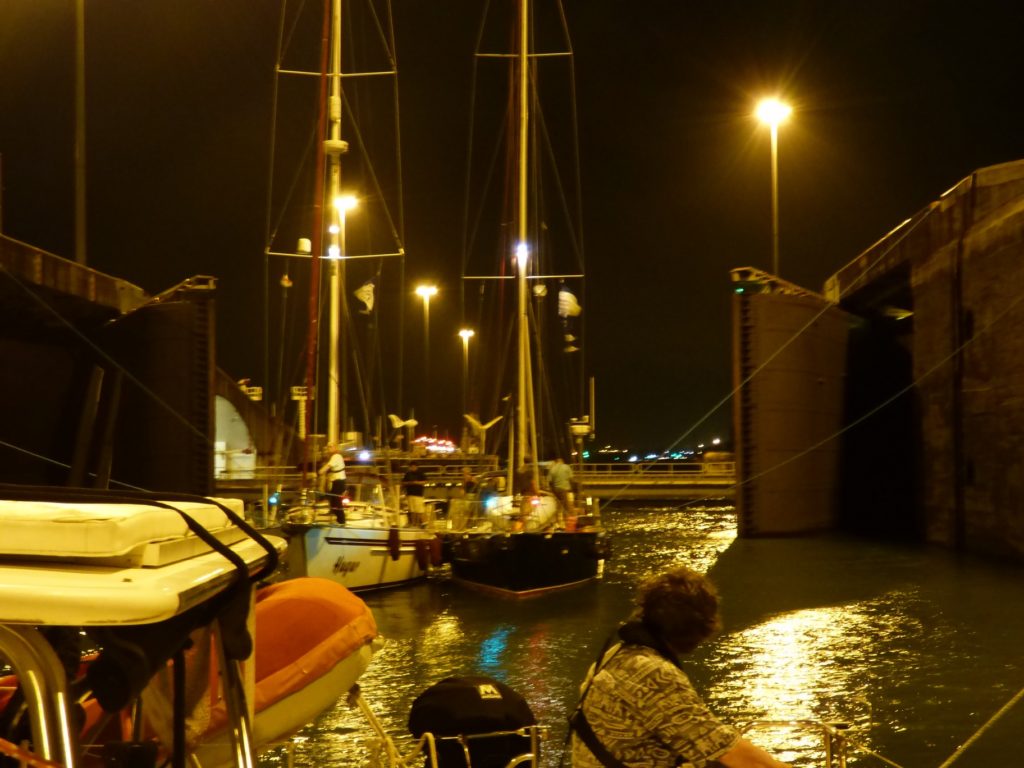
Gates closing behind us
After only a few minutes the lock gates closed and the water started rushing in. It was obvious that a lot of water was moving quickly, as the surface was boiling and the progress up the side of the lock was easy to follow. The Advisor said the chamber fills in 8-15 minutes, and with yachts it was likely to be kept a little slower to reduce the turbulence.
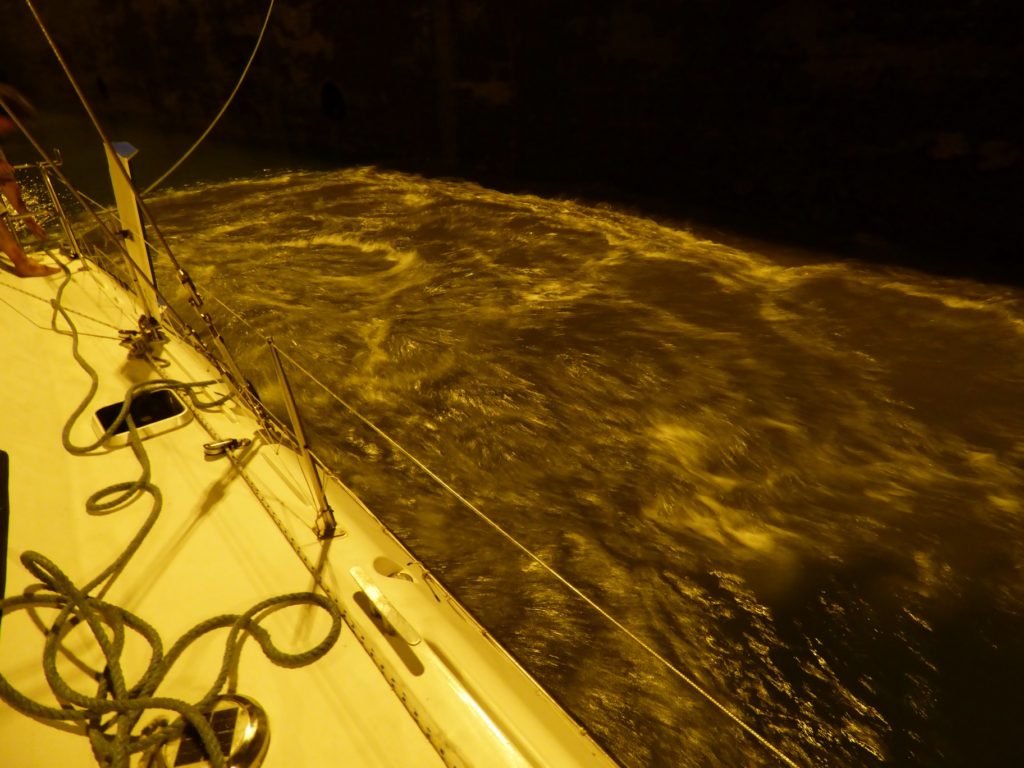
Turbulence as the chamber fills
Once the chamber was full, the gates opened at the far end and we were to move on to the next chamber. We pulled the mooring lines back to the yachts, and the guys on shore walked the heaving lines along to the next mooring point. Three chambers to get through, and by 23:20 we were heading out into Gatun Lake. The guys ashore all had their backpacks over their shoulders so were ready to go home.
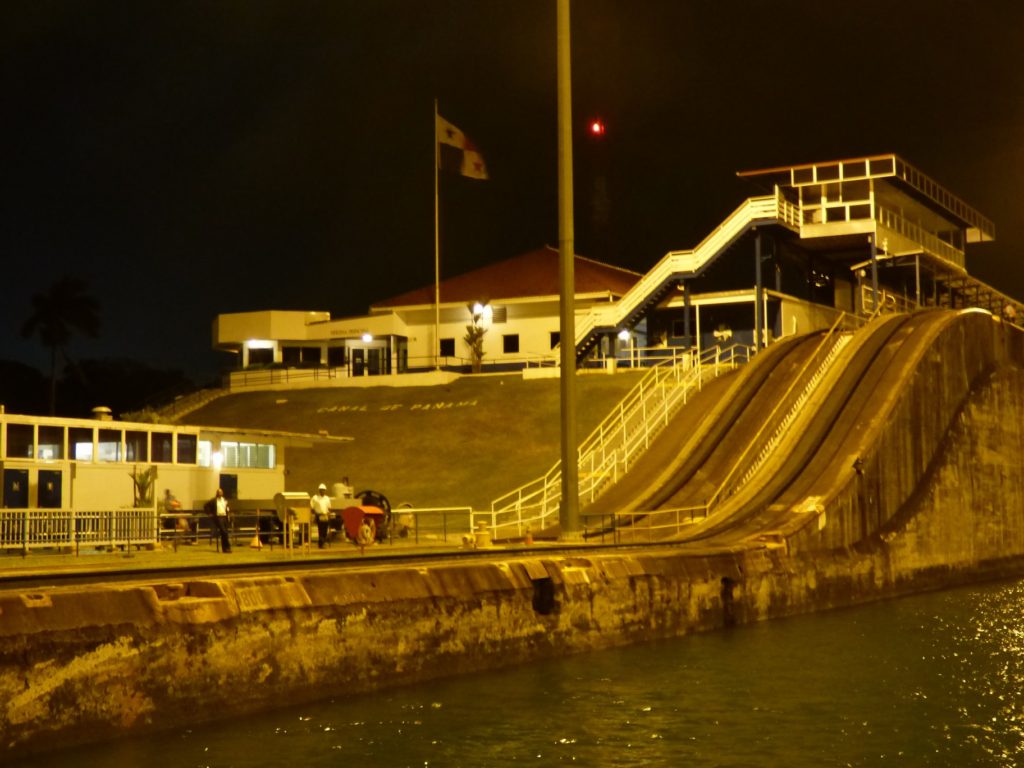
Gatun visitors centre

The control tower
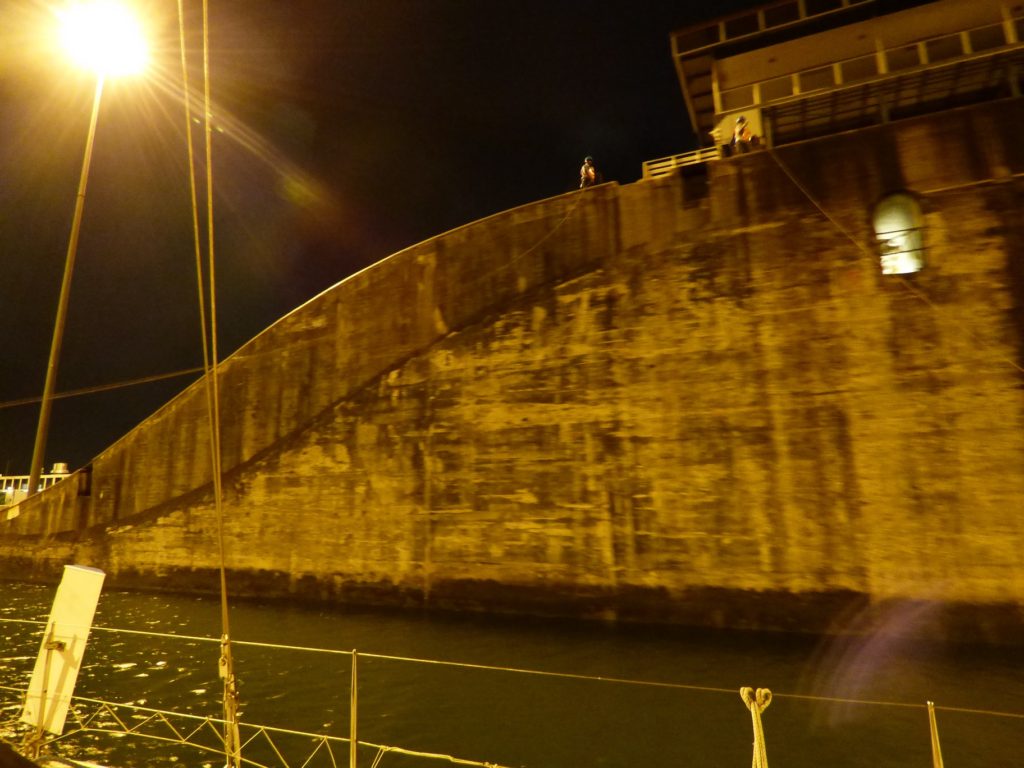
The shoreman walk the lines as we move into the next chamber
It went fairly smoothly despite being at night and everyone being first-timers. Some lessons learned:
- Make sure everybody is clear on who will be the linehandler for each line
- Ensure each linehandler knows how to tie a decent knot to attach the heaving line, preferably quickly
- The mooring lines should be flaked out on deck to ensure that they don’t tangle, because they move pretty quickly across to the guys on shore.
- The linehandlers need to keep taking up the slack in the lines as it appears, but in general they should keep the lines secure most of the time.
- Do not try to hold the weight of your yacht by hand – always make sure the lines are secure when any tension is likely to come on them. The motion from the locks filling is different to what you are used to
- As the guys walk up the slope between the chambers, watch that the heaving line doesn’t snag on the edges
- Do not untie the heaving lines until you are finished with the last chamber!
- Listen to the Advisor and the Captain throughout the process
All of the yachts motored around to a mooring buoy close to the visitors centre for the new lock expansion project. One guy was expected to jump onto the buoy to attach the lines.
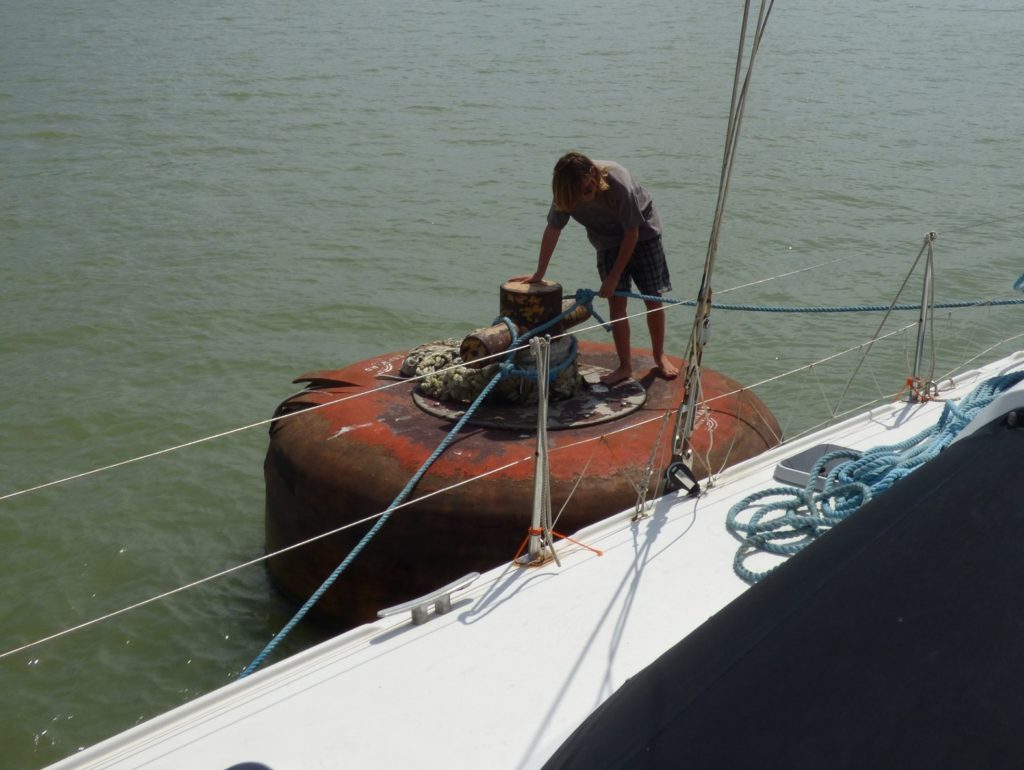
Lucky we had a young lad to jump across to the buoy
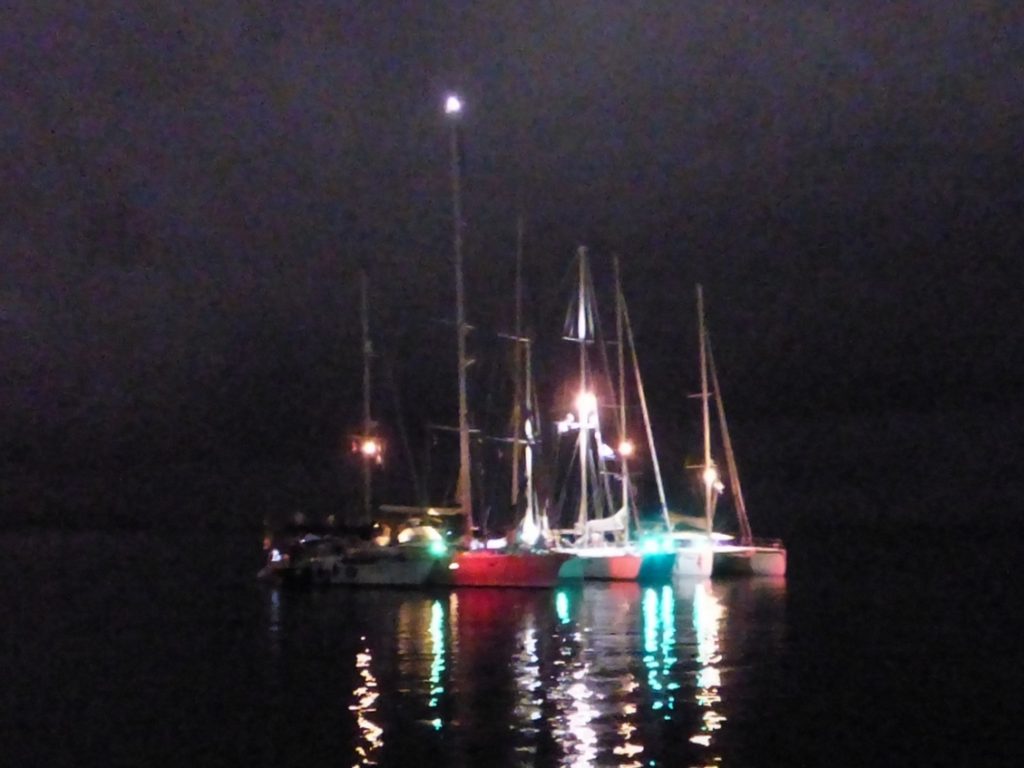
Rafted up on Gatun Lake
It was around 01:00 by the time we were able to go to bed, and the Advisor told us to expect his colleague to appear at 06:00. The others stayed up for some cake since Brian was too wound up, but we headed off for some sleep. With a hatch open, fan blowing and a long day behind us it was easier than we thought to sleep.
Day Two : Pedro Miguel and Miraflores Locks
The Panama Canal Authority boat did indeed turn up around 06:00 and soon we had Francisco the Advisor on board and we were underway around 06:30. Nobody was stirring on any of the other yachts so we wondered about the rush since we were due to go through the locks together again.
We could hear howler monkeys in the trees around us, and a few loud birds at that time of the morning but we couldn’t see any of them.
The trip across Gatun Lake was pleasant in the morning cool, and there were plenty of clouds around to protect us for most of the morning. Once the sun did come out properly it was extremely hot. We threaded our way through lots of anchored ships, then had the lake to ourselves for much of the trip across. Once in the Canal part there were big ships coming from the other direction. We set a sail for a while that gave us a nice push, even though you are officially not allowed to do this.
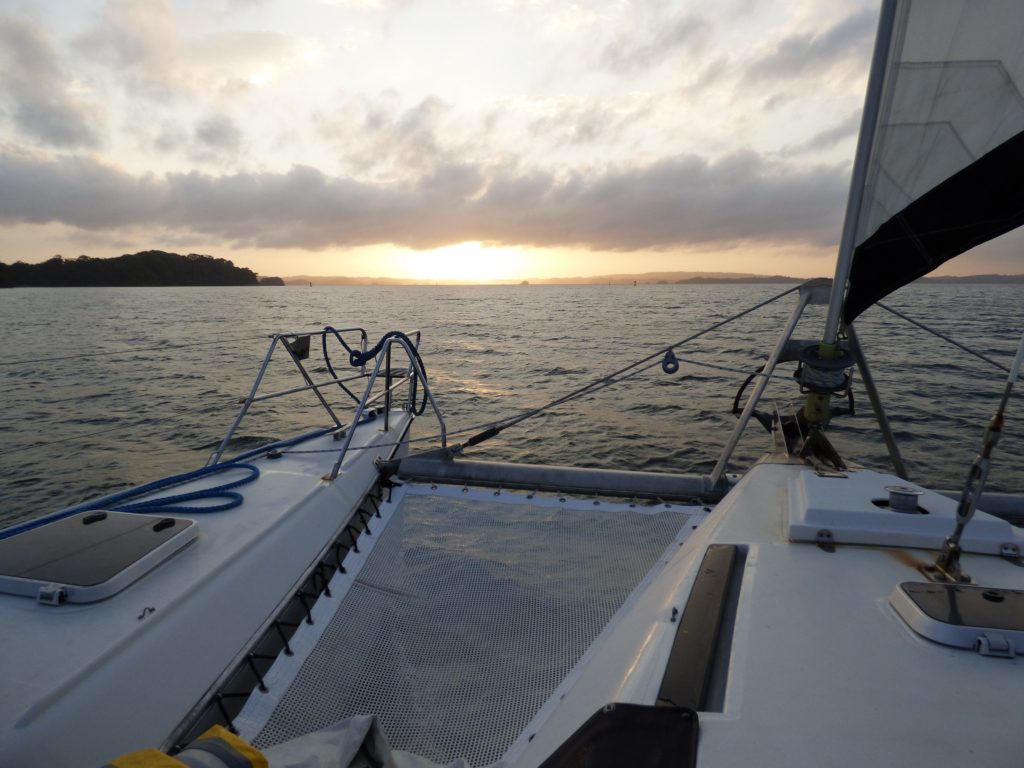
Can’t be a sail because we are not allowed!
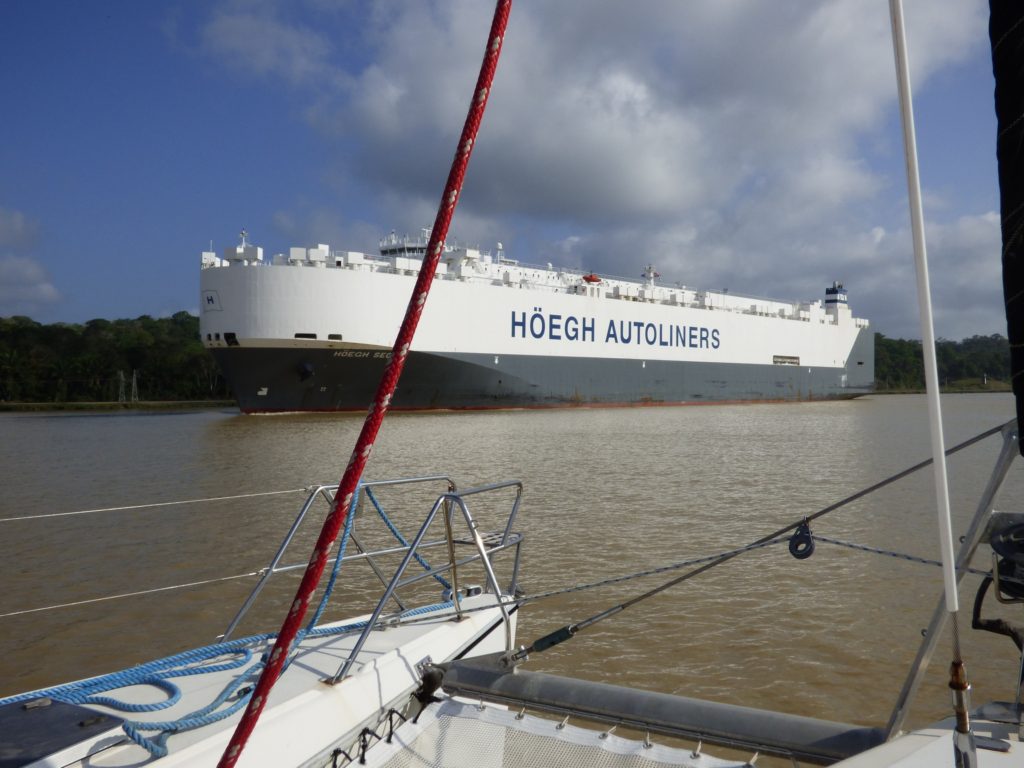
Big ships on the Canal
I chatted with Francisco and found out that the lake is currently one foot higher than usual because they had the best rain in three years last winter. Earlier last year they had an “incident” that he would not elaborate on, except to say that there were draft restrictions for a while because the lake was so low.
In the Culebra (aka Gaillard Cut) there were diggers and dredges everywhere, working on making everything bigger for the big ships expected through the expansion. They look so puny compared to the amount of dirt that obviously needs removing! Closer to the Pedro Miguel Lock we could see the diggers and machinery working on the bypass channel to the new expansion locks themselves.
Francisco informed us that we would be tying up to a mooring buoy and that we were likely to be doing a centre lockage by ourselves, because the boat that we nested with yesterday had turned back. He immediately added that the plan could change if the lockmaster had a different idea.
We passed under the impressive Centenario Bridge and were at the mooring buoy by 11:30. We had to wait for the ARC yachts to join us, before moving into the lock at 12:45.
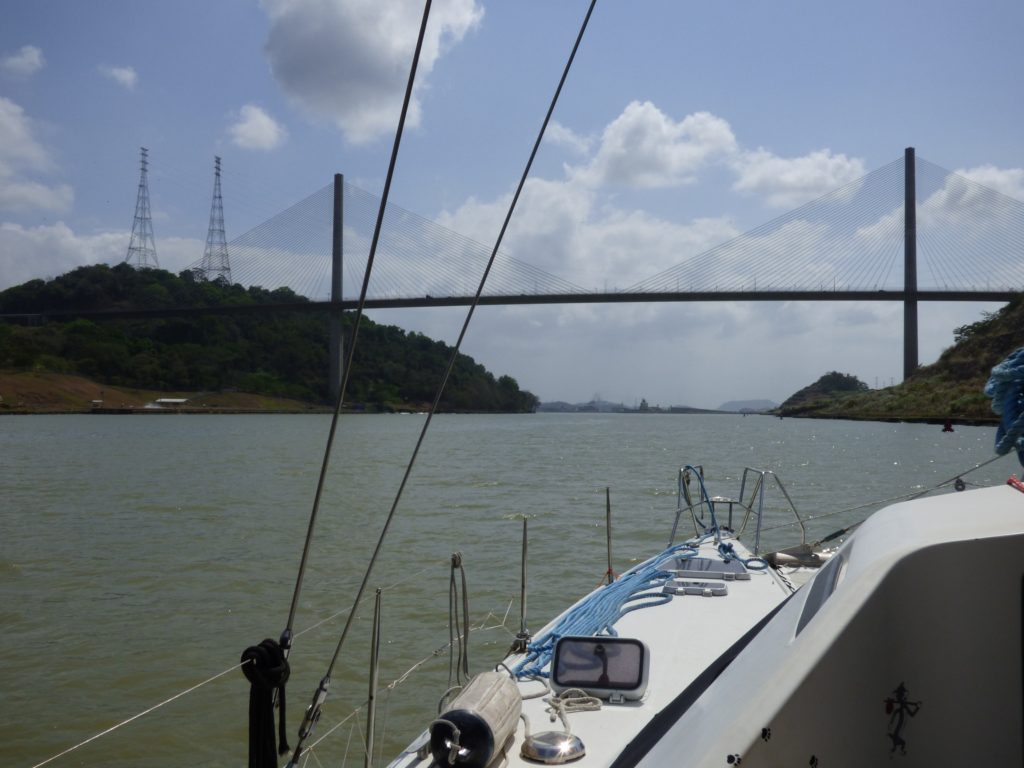
Centenario or Millenium Bridge
It was probably easier to do things without being tied to another yacht, and down locking was much calmer than going up. The water level moves quite quickly so we just needed to tend the lines and ease them out as necessary. Once again we had a strong tailwind, so the stern lines were left attached and the headlines adjusted.
- When down locking it is even more important to make sure the mooring lines are flaked out so they will run freely
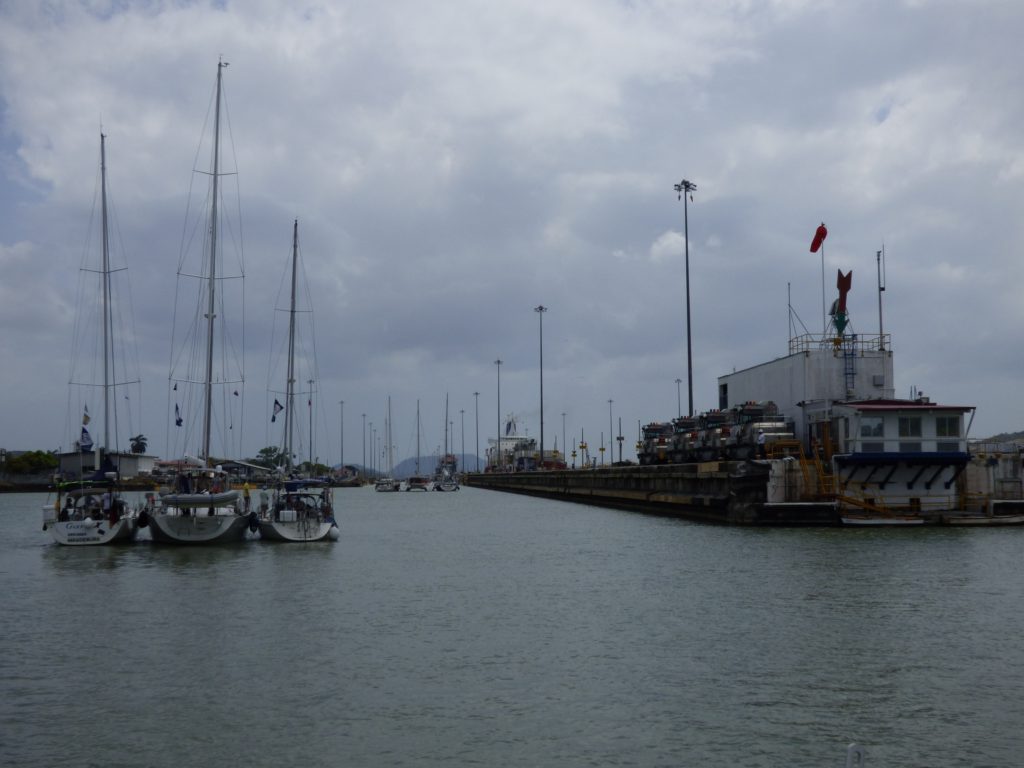
Heading into Pedro Miguel Lock
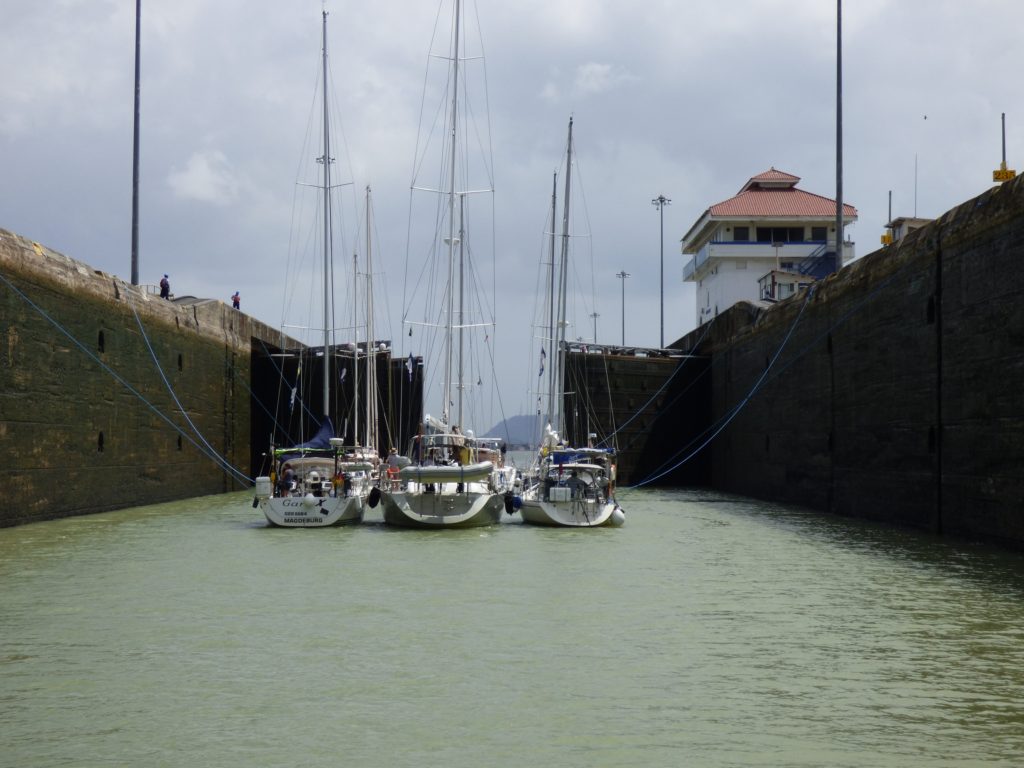
Gates closing
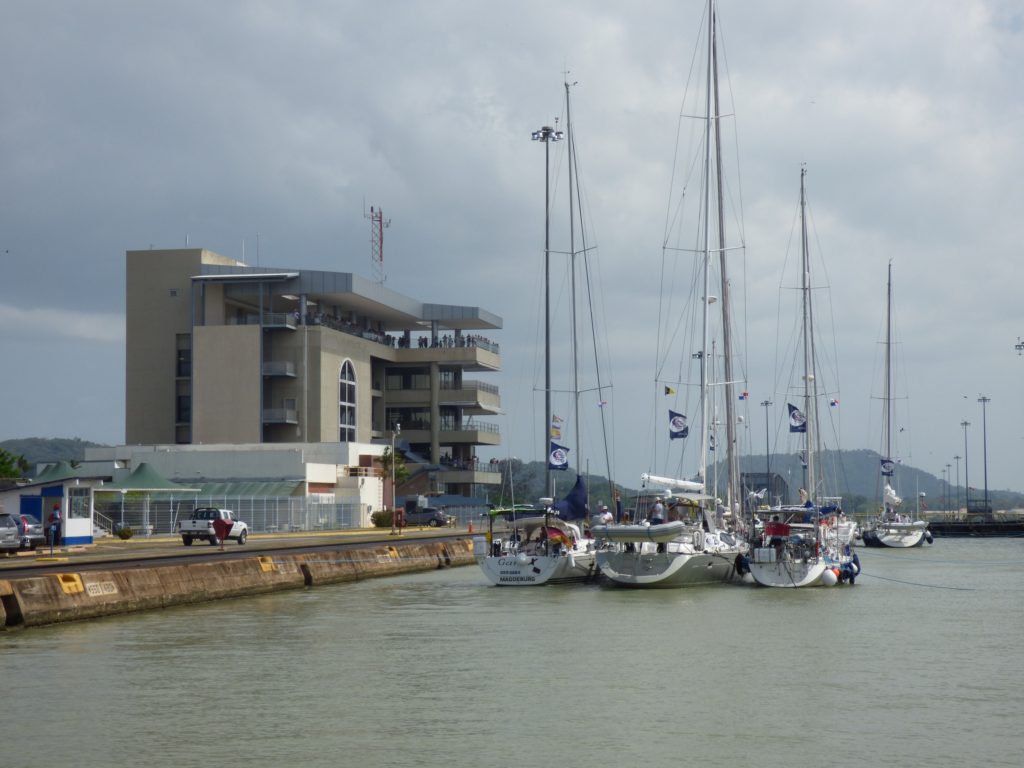
Miraflores visitor centre
A quick trip across the small Miraflores Lake and into the next locks. Once again an easier process in daylight with less turbulence. By 14:30 we were clear of the locks, and around 15:00 we passed under the Bridge of the Americas, where Russell and I could wave at our friends watching from the pool area of The Bridge.
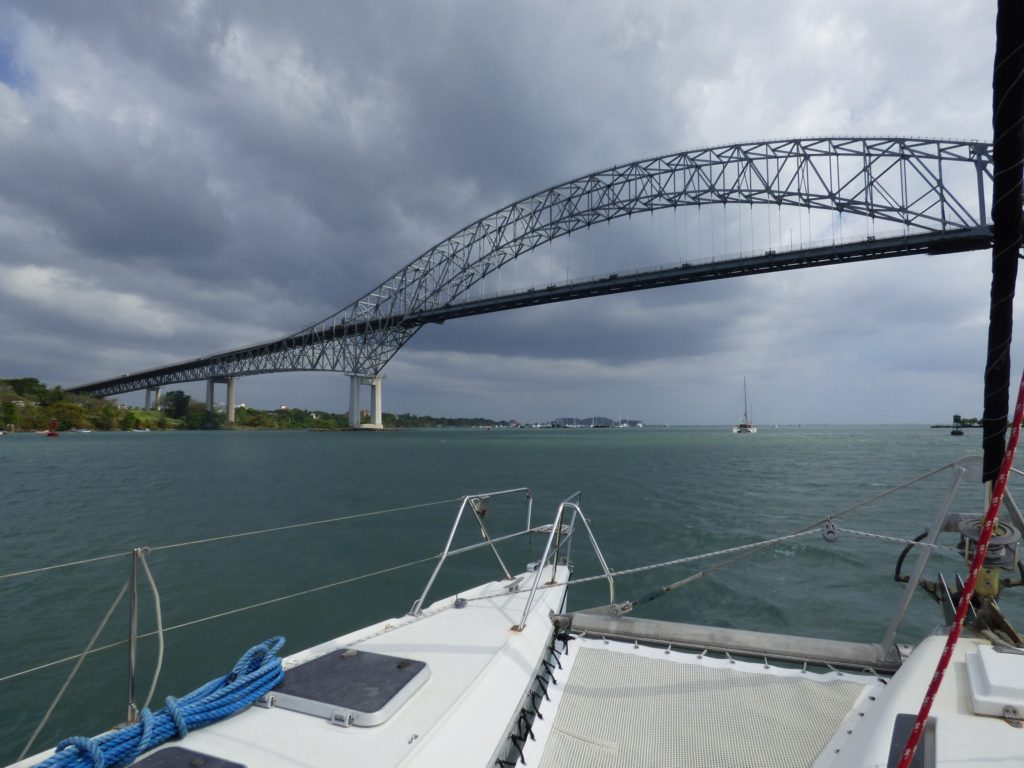
Bridge of the Americas
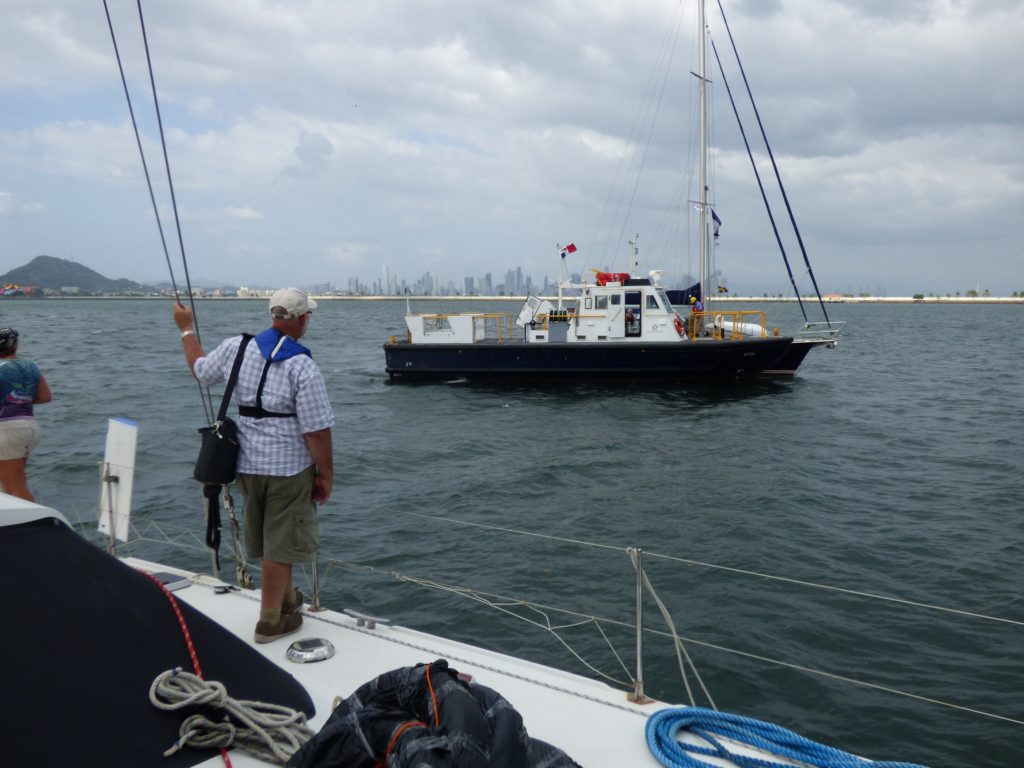
Advisor’s taxi
Balboa Yacht Club was full so we anchored at La Playita and Brian popped some champagne. Everybody was very excited about having passed through the Panama Canal!
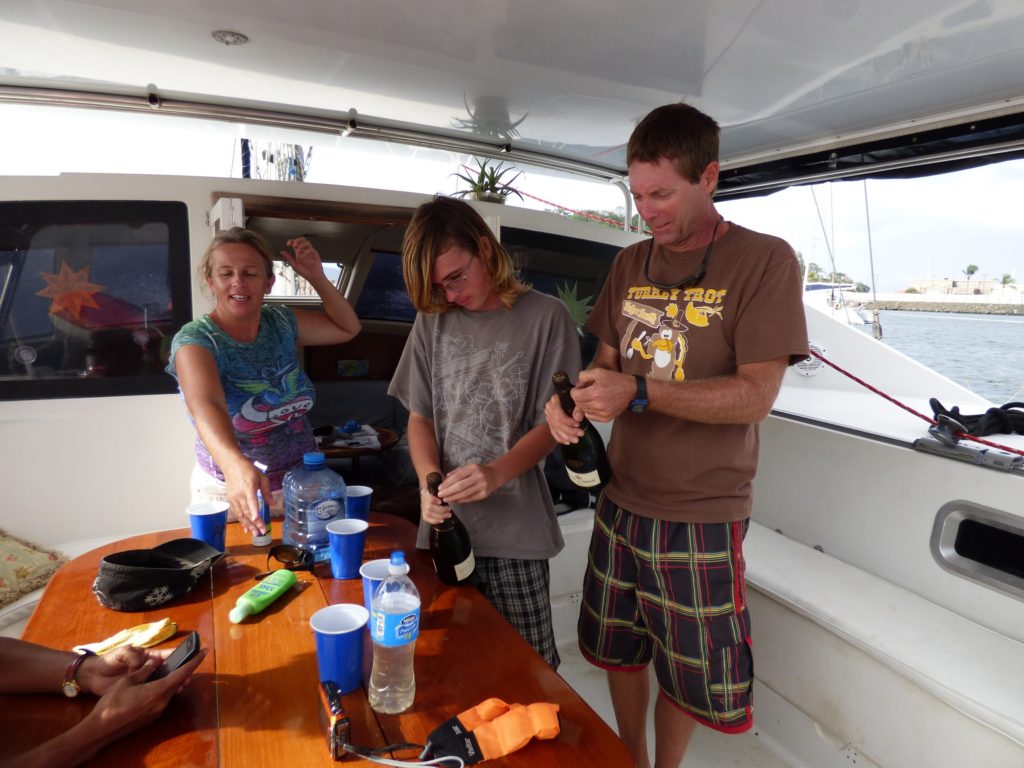
Champagne time!
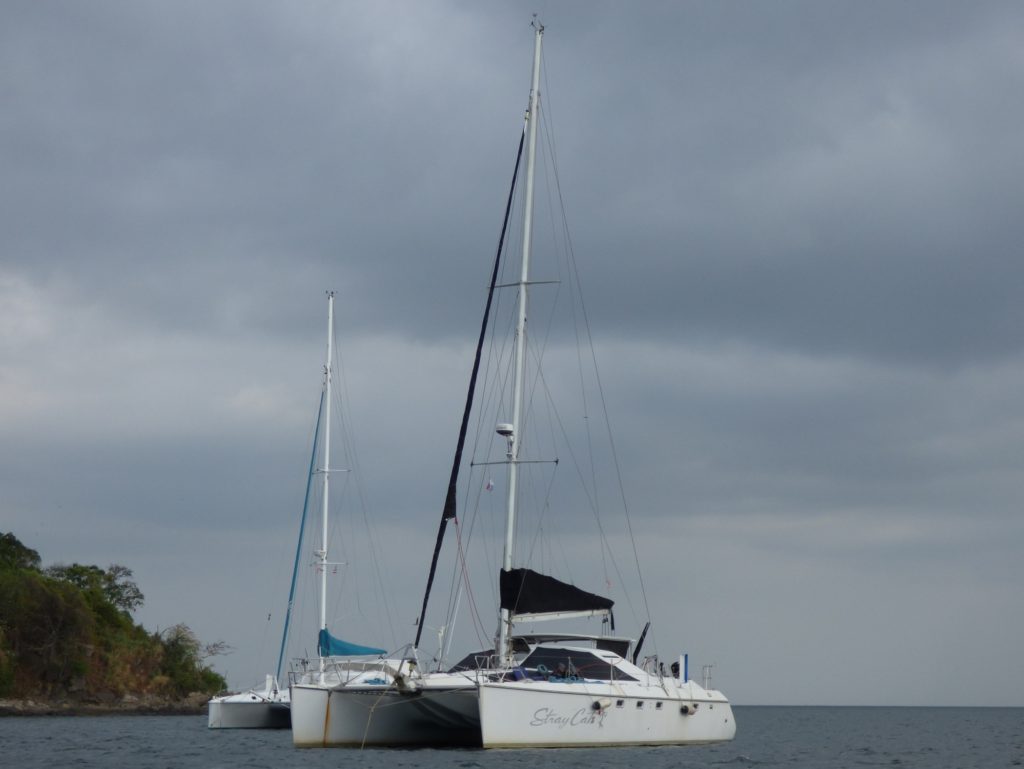
Leaving them to it
Brian took us ashore where we were accosted by the marina staff demanding money for using the dinghy dock! As they said we couldn’t leave until we paid, and there were several guys with guns standing close by, we called Brian to come and pay the $35 for a week pass. They even stipulate that the cost covers three people so it is a further $12.50 for each extra person. What a rip-off! Same logic as five beers in a bucket. You would think that they would have something in place for crew arriving after a Canal transit.
However, we thoroughly enjoyed our first Canal transit in a yacht, and we look forward to the next one.
